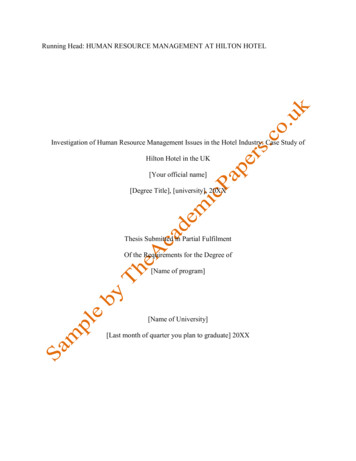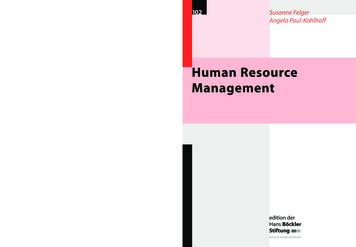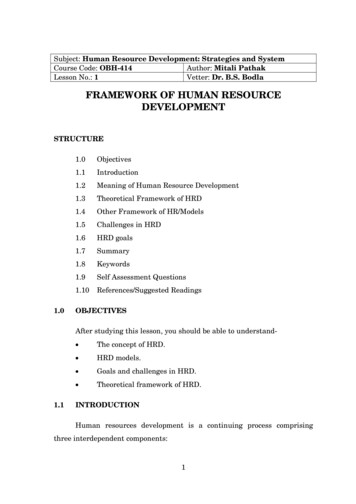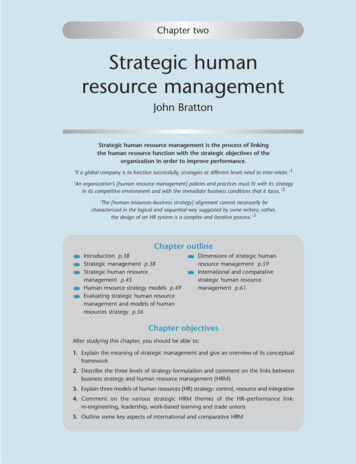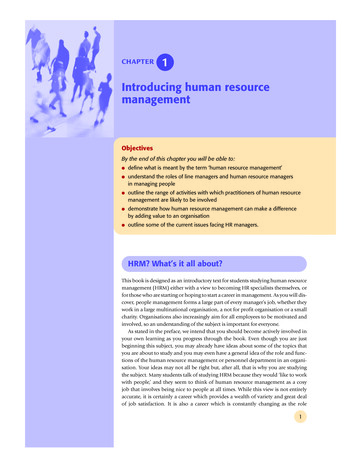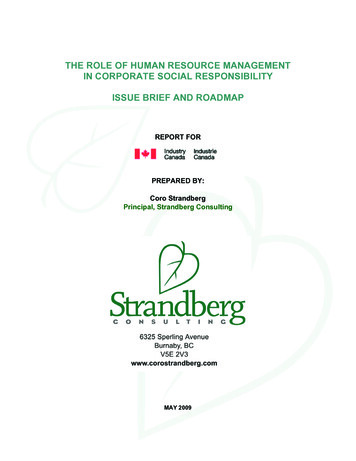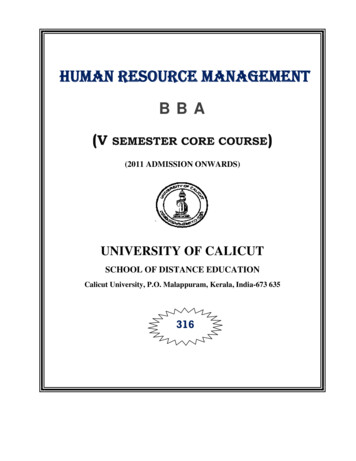
Transcription
Inte rnational Journal of Engineering Technology, Manage ment and Applied Scienceswww.ijetmas.com July 2015, Volume 3, Issue 7, ISSN 2349-4476The Role of Human Resource Management in Organizations*Mrs. B. Naga Parameswari, Assistant Professor, Department of Management Studies,Padmasri Dr. B. V. Raju Institute of Technology, Narsapur, Medak District,**Mr. V. Yugandhar, Sr.Assistant Professor, Department of Management Studies,Padmasri Dr. B. V. Raju Institute of Technology, Narsapur, Medak District,AbstractThe human resource function has gone from the traditional hire and fire role to a strategic partner at the table withfinance, operations and other business centers that are not centers of profit for the organization. The job of HR, as is thejob of all such departments, is to ensure that the business gets the most out of its employees. Another way to put this isthat the human resource management needs to provide a high return on the business's investment in its people. Thismakes it a highly complex function - because it deals with not just management issues but human ones as well. In thisarticle, we discuss the reasons for organizations to have a HRM strategy as well as the business drivers that make thestrategy imperative for organizational success. It is a fact that to thrive in the chaotic and turbulent businessenvironment, firms need to constantly innovate and be “ahead of the cu rve” in terms of business practices and strategies.It is fro m this motivation to be at the top of the pack that HRM becomes a valuable tool for management to --------------------------Key Words: Organization, Business, E nvironment, Human Resource, ------------------------Introduction:Human Resource Management includes conducting job analyses, planning personnel needs, recruiting theright people for the job, orienting and training, managing wages and salaries, providing benefits andincentives, evaluating performance, resolving disputes, and communicating with all employees at all levels.Examples of core qualities of HR management are extensive knowledge of the industry, leadership, andeffective negotiation skills, formerly called personnel management.Any organization, without a proper setup for HRM is bound to suffer from serious problems whilemanaging its regular activities. For this reason, today, companies must put a lot of effort and energy intosetting up a strong and effective HRM. Aristotle told us that ‗the whole is more than the sum of its parts‘, thisis certainly true when it comes to having all managers fully understanding the organization‘s documentedBusiness Plan and ensuring the alignment of management thinking simply the process of ensuring that allmanagers are working and driving the organization in the same direction.Meaning: Before we define HRM, it seems pertinent to first define the term ‗human resources‘. In commonparlance, human resources means the people. However, different management experts have defined humanresources differently.Definition: Michael J. Jucius has defined human resources as ―a whole consisting of inter-related, interdependent and interacting physiological, psychological, sociological and ethical components‖.According to Flippo ―Personnel management, or say, human resource management is the planning,organizing, directing and controlling of the procurement development compensation integration, 4intenance,and separation of human resources to the end that individual, organizational and social objectives a reaccomplished‖.Objective of Study1.To study the need of Human Resource Management2.To study the functions of Human Resource Management3.To study the History of Human resource Management4.To study the importance of Human Resource ManagementResearch Methodology: The study mainly relies on secondary data. The sources of data include Books,Magazines, Research Articles, News Papers, Conference Proceedings, Research Journals etc.58B. Naga Parameswari, V. Yugandhar
Inte rnational Journal of Engineering Technology, Manage ment and Applied Scienceswww.ijetmas.com July 2015, Volume 3, Issue 7, ISSN 2349-4476Review of Literature: Review of literature identified nine essential HRM practices namely; recruitment andselection, training and development, performance appraisal, career planning, Job definition, compensation andreward, and employee participation. Recruitment and selection primarily aims at attracting maximum numberof highly talented applicants and selecting the best to achieve competitiveness.Training and development generate tangible outcome (improved productivity, quality of products andservices, and resource optimization), and intangible results in terms of enhanced self esteem, high morale, andsatisfaction of employees due to acquisition of additional knowledge, skills, and abilities. Kun (2000) stressedthat companies should invest heavily in training the workforce for implementation of customer focusedstrategy. Blair and Sisakhti (2007)found that expenditures on training and development yield enormousbenefits. Researchers have concluded that investment in training yields strategic advantage to theorganizations (Bitner and Zeithmal, 2001).Performance appraisal is based on demonstrated achievement of performance objectives established pertainingto a specified job within a given time period (Arthur, 1994; Fey et al., 2000). This process plays a vital role ininfluencing the perception of employees about self and about their contribution toward organizational goals.The system should be based on fairness, objectivity, inclusiveness, ethicality, standardization, and widelycommunicated. Regular monitoring of the performance and constant feedback about performance is essentialto get the desired results.performance appraisal that contributes toward superior performance by workforce Compensation includes allforms of monetary returns and allied services provided to employees (Milkovich and Newman, 1999 ). Acomprehensive compensation mix augmented by an effective system of disbursement plays an effective rolein attracting the best candidates, shaping employees, behaviour and performance outcome, and facilitatesretention of talents. Application of competencies enhances performance and improves effectiveness.Need for HRM:Human Resource Management is needed to achieve the following objectives. To provide, create, utilize and motivate employees to accomplish organizational goals. To create opportunities, to provide facilities, necessary motivation to individual and group for theirgrowth with the growth of the organization by training and development, compensation etc. To employ the skills and ability of the workforce efficiently, i.e., to utilize human resourceseffectively To create a sense and feeling of belongingness team-spirit and encourage suggestions fromemployees. To help maintain ethical policies and behavior inside and outside the organization. To maintain high moral and good human relation within the organization. To secure integration of individual and groups in securing organizational effectiveness To manage change to the mutual advantage of individuals, groups, the organization and the society. To ensure that, there is no threat of unemployment, inequalities, adopting a policy recognizing meritand employee contribution, and condition for stability of employment. To increase to the fullest the employee‘s job satisfaction and self-actualization; it tries to prompt andstimulate every employee to realize his potential.An organization cannot build a good team of workingprofessionals without good Human Resources. The keyfunctions of the Human Resources Management (HRM)team include recruiting people, training them, performanceappraisals, motivating employees as well as workplacecommunication, workplace safety, and much more.The beneficial effects of these functions are discussed here:Recruitment and Training: This is one of the major responsibilities of the human resource team. The HRmanagers come up with plans and strategies for hiring the right kind of people. They design the criteria whichis best suited for a specific job description. Their other tasks related to recruitment include formulating the59 B. Naga Parameswari, V. Yugandhar
Inte rnational Journal of Engineering Technology, Manage ment and Applied Scienceswww.ijetmas.com July 2015, Volume 3, Issue 7, ISSN 2349-4476obligations of an employee and the scope of tasks assigned to him or her. Based on these two factors, thecontract of an employee with the company is prepared. When needed, they also provide training to theemployees according to the requirements of the organization. Thus, the staff members get the opportunity tosharpen their existing skills or develop specialized skills which in turn will help them to take up some newroles.Performance Appraisals: HRM encourages the people working in an organization, to work according to theirpotential and gives them suggestions that can help them to bring about improvement in it. The teamcommunicates with the staff individually from time to time and provides all the necessary informationregarding their performances and also defines their respective roles. This is beneficial as it enables them toform an outline of their anticipated goals in much clearer terms and thereby, helps them execute the goals withbest possible efforts. Performance appraisals, when taken on a regular basis, motivate the employees.Maintaining Work Atmosphere:This is a vital aspect of HRM because the performance of an individual inan organization is largely driven by the work atmosphere or work culture that prevails at the workplace: Agood working condition is one of the benefits that the employees can expect from an efficient human resourceteam. A safe, clean and healthy environment can bring out the best in an employee. A friendly atmospheregives the staff members job satisfaction as well.Managing Disputes: In an organization, there are several issues on which disputes may arise between theemployees and the employers. You can say conflicts are almost inevitable. In such a scenario, it is the humanresource department which acts as a consultant and mediator to sort out those issues in an effec tive manner.They first hear the grievances of the employees. Then they come up with suitable solutions to sort them out. Inother words, they take timely action and prevent things from going out of hands.Developing Public Relations:The responsibility of establishing good public relations lies with the HRM to agreat extent. They organize business meetings, seminars and various official gatherings on behalf of thecompany in order to build up relationships with other business sectors. Sometimes, the HR de partment playsan active role in preparing the business and marketing plans for the organization too.Milestones in the History of HRM:18901910Frederick Taylor develops his ideas on scientific management. Tay lor advocates scientific selection ofworkers based on qualifications and also argues for incentive-based compensation systems to motivateemp loyees.1910Many companies establish departments devoted to maintain ing the welfare of workers. The d iscipline of1930industrial psychology begins to develop. Industrial psychology, along with the advent of World War I,leads to advancements in emp loyment testing and selection.1930The interpretation of the Hawthorne Studies' begins to have an impact on management thought and1945practice. Greater emphasis is placed on the social and informal aspects of the workplace affecting wo rkerproductivity. Increasing the job satisfaction of workers is cited as a means to increase their productivity.1945In the U.S., a tremendous surge in union membership between 1935 and 1950 leads to a greater emphasis1965on collective bargaining and labor relations within personnel management. Co mpensation and benefitsadministration also increase in importance as unions negotiate paid vacations, paid holidays, and insurancecoverage.1965The Civil Rights movement in the U.S. reaches its apex with passage of the Civil Rights Act of 1964. The1985personnel function is dramatically affected by Title VII of the CRA, which prohibits discrimination on thebasis of race, color, se x, relig ion, and national origin. In the years following the passage of the CRA, equalemp loyment opportunity and affirmat ive action become key hu man resource management responsibilities.1985Three trends dramatically impact HRM. The first is the increasing diversity of the labor force, in terms ofpresent age, gender, race, and ethnicity. HRM concerns evolve from EEO and affirmat ive action to "managingdiversity." A second trend is the globalization of business and the accompanying technological revolution.These factors have led to dramatic changes in transportation, communication, and labor markets. The thirdtrend, which is related to the first two, is the focus on HRM as a "strategic" function. HRM concerns andconcepts must be integrated into the overall strategic planning of the firm in order to cope with rapidchange, intense competition, and pressure for increased efficiency.60B. Naga Parameswari, V. Yugandhar
Inte rnational Journal of Engineering Technology, Manage ment and Applied Scienceswww.ijetmas.com July 2015, Volume 3, Issue 7, ISSN 2349-4476Significance of HRM:The significance of HRM can be discussed under the following headings.Organization Significance: HRM is of vital importance to the individual organization as a means for achievingtheir objectives.It contributes to the achievement of organizational objectives in the following ways: Good human resource practice can help in attracting and retaining the best people in the organization. Developing the necessary skills and right attitudes among the employees through training,development, performance appraisal, etc. Securing willing cooperation of employees through motivation, participation, grievance handling, etc. Effective utilization of available human resources. Ensuring that enterprise will have in future a team of competent and dedicated employees.Social Significance : Social significance of HRM lies in the need satisfaction of personnel in the organization.Since these personnel are drawn from the society, their effectiveness contributes to the welfare of the society.Society, as a whole, is the major beneficiary of good human resource practice.i. Employment opportunities multiply.ii. Eliminating waste of human resources through conservation of physical and mental health.iii. Scare talents are put to best use. Companies that pay and treat people well always race ahead of others anddeliver excellent results.Professional Significance : Professional significance of HRM lies in developing people and providing healthyenvironment for effective utilization of their capabilities. This can be done by:1. Developing people on continuous basis to meet challenge of their job.2. Promoting team-work and team-spirit among employees.3. Offering excellent growth opportunities to people who have the potential to rise.4. Providing environment and incentives for developing and utilising creativity.Why is a Human Resources Department Important?The question of whether a company needs a Human Resources (HR)department is not a simple one to answer. If we ask the question to avariety of entrepreneurs, CEOs, and HR professionals and we arelikely to get a variety of answers. For instance, many experts willtell us that the number of employees in a company is thedetermining factor. A lot of companies with total employees under20 assume that they don‘t need an HR department. But size isn‘t theonly issue to think about. Other considerations include: The scope of HR services needed Whether requirements are limited to transactional services Are strategic services mandatory Will the department operate as a cost or profit centerIn reality, HR functions must be conducted for every company—no matter how small or large. So properlyframed, the question to ask is: ―What is the most effective way that HR services can be delivered by aCompany?‖ Is it better to have an in-house HR department doing the job or is it better to partner with outsideHR experts, using a variety of vendors or even to a single source? For example, many organizations find thatit‘s more convenient, and more cost effective, to outsource transactional services such as payroll, tax, andbenefits administration, while partnering with a strategic HR partner to deliver high value consultation.If it is a small- to mid-sized company with an employee base of blue-collar or unskilled workers and it onlyrequires transactional services, outsourcing coordinated by a single in-house employee may work best. Whena growing professional services business like the one mentioned earlier needs both transactional and strategicHR services, a single-source professional employer organization (PEO) may be the way to go. A PEO canprovide a comprehensive menu of HR services, including robust benefits packages that will allow it to attracttop talent. On the other hand, if it is a large manufacturing company with over 300 workers, its size gives the61B. Naga Parameswari, V. Yugandhar
Inte rnational Journal of Engineering Technology, Manage ment and Applied Scienceswww.ijetmas.com July 2015, Volume 3, Issue 7, ISSN 2349-4476clout to negotiate competitive rates with benefits providers—therefore an in-house HR department may workfor it.Importance of HRM:Ten Reasons Why the Human Resources Department Is Important:1.Human Capital Value : Having an in-house human resources function is important. An in-househuman resources staff or a human resources expert on staff can increase the understanding of how importanthuman capital is to the company's bottom line. For small businesses, in particular, human capital is criticalbecause so many smaller firms have employees who perform cross-functional duties. With a smallerworkforce, if just one person leaves, it leaves the company with a huge gap to fill and a potential threat to thecompany's profitability.2.Conflict Resolution: Workplace conflict is inevitable, given the diversity of personalities, workstyles, backgrounds and levels of experience among employees. A human resources manager or a staff personspecially trained to handle employee relations matters can identify and resolve conflict between twoemployees or a manager and employee and restore positive working relationships.3.Budget Control: Human resources curbs excessive spending through developing methods fortrimming workforce management costs, which includes negotiating better rates for benefits such as health carecoverage. In addition, human resources ensures competitive and realistic wage-setting based on studying thelabor market, employment trends and salary analysis based on job functions. As some small businesses havebudget constraints, this human resources function is especially helpful.4.Training and Development: Human resources conducts needs assessments for the organization'scurrent workforce to determine the type of skills training and employee development necessary for improvingskills and qualifications. Companies in the beginning or growth phases can benefit from identifying trainingneeds for existing staff. It's much less expensive than the cost to hire additional staff or more qualifiedcandidates. In addition, it's a strategy that also can reduce turnover and improve employee retention.5.Employee Satisfaction: Human resources specialists usually are charged with the responsibility ofdetermining the level of employee satisfaction -- often an ambiguous measurement at best. With carefullydesigned employee surveys, focus groups and an exit interview strategy, human resources determines whatunderlies employee dissatisfaction and addresses those issues to motivate employees.6.Performance Improvement: Human resources develops performance management systems. Withouta human resources staff person to construct a plan that measures performance, employees can wind in jobsthat aren't suitable for their skills and expertise. Additionally, employees whose performance falls below theemployer's expectations can continue on the payroll, thereby creating wasted money on low-performingemployees.7.Cost Savings: The cost to hire new or replacement workers, including training and ramp-up time, canbe exorbitant for employers, especially small businesses. With a well-constructed recruitment and selectionprocess, the human resources function can minimize expenses regarding advertising job postings, training newemployees and enrolling new employees in benefits plans.8.Sustaining Business: Through succession planning that human resources develops, the companyidentifies employees with the promise and requisite capabilities to eventually transition into leadership roleswith the company. This is an important function as it can guarantee the organization's stability and futuresuccess.9.Corporate Image: Businesses want to be known as the "employer of choice." Employers of choiceare the companies that receive recognition for the way they treat employees; they are the companies for whompeople want to work. Becoming an employer of choice means human resources balances recruiting the mostqualified applicants, selecting the most suitable candidates and retaining the most talented employees.10.Reliability: Human resources ensures the workforce embraces the company's philosophy and businessprinciples. From the perspective of a small business, creating a cohesive work environment is imperative. Thefirst opportunity human resources has to accomplish this is through wise hiring decisions that identifydesirable professional traits, as well as orientation and on-boarding programs.62B. Naga Parameswari, V. Yugandhar
Inte rnational Journal of Engineering Technology, Manage ment and Applied Scienceswww.ijetmas.com July 2015, Volume 3, Issue 7, ISSN 2349-4476Conclusion: The practice of HRM must be viewed through the prism of overall strategic goals for theorganization instead of a standalone tint that takes a unit based or a micro approach. The idea here is to adopta holistic perspective towards HRM that ensures that there are no piecemeal strategies and the HRM policyenmeshes itself fully with those of the organizational goals. For instance, if the training needs of theemployees are simply met with perfunctory trainings on omnibus topics, the firm stands to lose not only fromthe time that the employees spend in training but also a loss of direction. Hence, the organization that takes itsHRM policies seriously will ensure that training is based on focused and topical methods.References: Robert L Mathis, John Jackson, Manas Ranjan Tripathy Human Resource Management – A South AsianPerspective, Cengage Learning 2012 Dessler, Gary. Human Resource Management. 10th ed. Englewood Cliffs, NJ: Pearson/Prentice-Hall,2004. Lado, A.A., and M.C. Wilson. "Human Resource Systems and Sustained Competitive Advantage: ACompetency-Based Perspective."Academy of Management Review 19, no. 4 (1994): 699–727 Kleiman, Lawrence S. Human Resource Management: A Managerial Tool for Competitive Advantage.Cincinnati: South-Western College Publishing, 2000. Shyamkant Gokhale Personnel Management, Everest ,2012 Hiltrop, J.-M. (1996),The Impact of Human Resource Management on organizational Performance: Theory and Research‘, European Management Journal www.smallbusiness.chron.com www.trinet.com www.humanresourceexcellence.com63B. Naga Parameswari, V. Yugandhar
1. To study the need of Human Resource Management 2. To study the functions of Human Resource Management 3. To study the History of Human resource Management 4. To study the importance of Human Resource Management Research Methodology: The study mainly relies on secondary

